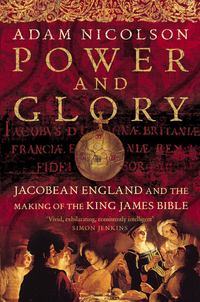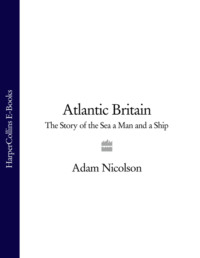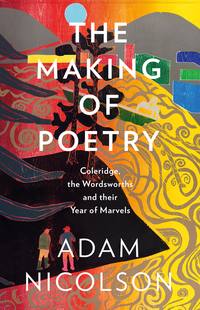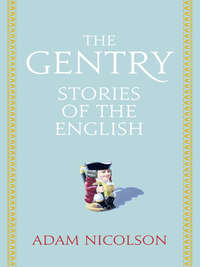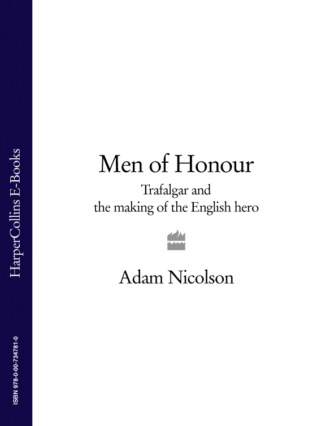
Полная версия
Men of Honour: Trafalgar and the Making of the English Hero

MEN OF HONOUR
Trafalgar and the Making of the English Hero
ADAM NICOLSON

By the same author
Wetland: Life in the Somerset Levels Restoration: The Rebuilding of Windsor Castle Perch Hill: A New Life Sea Room Power and Glory Atlantic Britain
Table of Contents
Cover Page
Title Page
By the same author
Preface
Part I: Morning
Chapter 1: Zeal
Chapter 2: Order and Anxiety
Chapter 3: Honour
Chapter 4: Love
Chapter 5: Boldness
Part II: Battle
Chapter 6: Violence
Chapter 7: Humanity
Chapter 8: Nobility
Bibliography
Index
Acknowledgements
About the Author
Copyright
About the Publisher
Preface
There is a long tradition of English violence. More Catholics were burned at the stake in 16th-century England than in any other country in Europe. A higher percentage of the population died in the English Civil War than in the French Revolution. The suppression and brutalisation of the Scottish Highlanders after Bonnie Prince Charlie’s rebellion in 1745-6 was the scandal of enlightened Europe. All this was part of the nation from which Nelson came. He was able at Trafalgar, as he had been at the Nile and Copenhagen, to summon a scale of aggression from his fleets that seems to have drawn on the deepest levels of common consciousness among his men. This is a difficult area to address, but essential: how does one read into the behaviour of a fighting fleet the deep half-conscious preoccupations of the people who man its ships? How do the semi-understood but widely inherited ideas about purpose, violence and victory, which are present in any evolved society, shape the way men behave in battle? Battle is not simply a question of ideology, military expertise or technology. Deeper and more personal forces are in play and intimate battle, of the kind Nelson invited and created, inevitably engages men at their innermost levels.
By 1805, the sequence of violent and revolutionary events in Europe over the previous fifteen years had established in England—or, to be strict, re-summoned—a form of millenarian fever which had not been seen since the 17th century. The template for this fever came from the prophets of the Old Testament, from Deuteronomy, Daniel, Ezekiel and Isaiah in particular, and from the Book of Revelation which draws on them. Deep in the Jewish tradition, and radiantly powerful in those books, is the idea that a moment of fearful justice will come, when the wrath of the divine descends on earth. It will know no compromise. Its very violence is a measure of its goodness.
If I whet my glittering sword, and mine hand take hold on judgment; I will render vengeance to mine enemies, and will reward them that hate me. I will make mine arrows drunk with blood, and my sword shall devour flesh; with the blood of the slain and of the captives, from the beginning of revenges upon the enemy. Rejoice, O ye nations, with his people: for he will avenge the blood of his servants, and will render vengeance to his adversaries.
That is the tradition drawn on by the blood-drenched visions of the end of time in Revelation. In this shared vision of the Judaeo-Christian-Islamic world, the moment of utter violence gives way to the moment of utter peace, the tranquillity of the Kingdom of God, the future dream time of the millennium, when all striving is over and all wickedness banished. There will be no peace until the violence is done. Peace is inaccessible without the violence, because violence is righteousness in action. Apocalypse is the route to millennium.
These movements have always emerged in English history at periods of flux and crisis: during the Peasants’ Revolt, early in the 16th century during the first years of the Reformation, in the lead-up to the Civil War in the mid-17th century, in the 1790s and again in the 1820s and 30s at a time of widespread uncertainty over the reform and democratisation of British political institutions. Never were they more powerful than in the years before Trafalgar. The twinning of apocalypse and millennium, of violence leading to peace, is everywhere you look. For English radicals, the French Revolution was itself a sign that the time had come when blood would be shed and peace would descend on all men. The Pitt government, bearing down heavily on any hint of revolutionary thought, was, in this cosmic drama, the agency of evil. House-to-house searches were made; registers of lodgers compiled; citizens denounced for ‘incivism’ if they did not sign a declaration of loyalty to the constitution. Semi-compulsory collections, for all the sailors and the troops, were set up as a means of testing loyalty to the government: if you were loyal you gave in your flannel waistcoats, mitts, drawers, caps, shirts, stockings, shoes, trousers, boots, sheets and greatcoats. If you did not, your loyalty fell under suspicion.
By the mid-1790s, as the pressure of the law came down, and as radicalism was driven underground, there was an eruption of millenarian fantasy. Richard Brothers, a retired naval lieutenant on half pay, spoke to the people. His books and pamphlets went through edition after edition on both sides of the Atlantic. ‘All nations have drunk of the wine of the wrath of Babylon’s fornications,’ he told his giddy listeners, ‘and the kings of the earth have committed fornication with her, and the merchants of the earth are waxed rich through the abundance of her delicacies.’ His words were, in a subterranean way, pregnant with extreme violence. One evening he saw ‘a large River run through London coloured with human blood.’
These were the ‘signs of mercy’—the violence was beautiful—and after them there was to be an era of universal brotherhood. ‘All shall be as one people, and of one mind…The time is come, and now is the whore of Babylon falling, and will fall to rise no more. Go forth then, ye Sons of Eternal Light, and instruct the Sons of Ignorance and Darkness…There shall be no more war, no more want, no more wickedness; but all shall be peace, plenty and virtue.’
In 1795 the Privy Council had him arrested and put in a lunatic asylum. His disciples clamoured year after year for his release. But his following continued. A prophet called Ebenezer Aldred, with flowing grey hair, floated in the Thames distributing his booklets of doom. The lost tribes of Israel surfaced in Birmingham and Wapping. Robert Southey sarcastically described how ‘One madman printed his dreams, another his day visions; one had seen an angel come out of the sun with a drawn sword in his hand, another had seven fiery dragons in the air, and hosts of angels in battle array.’
For the non-enfranchised masses of early 19th-century England, these visions felt like access to a new and potent reality; and it is from those social levels that Nelson’s fleet was manned. In 1801, the most powerful of all these movements erupted in the West Country (the navy’s principal recruiting ground). Joanna Southcott, a Devon farmer’s daughter, became the conduit for incantatory and apocalyptic visions which gave rise to a national movement both among the poor and among the frustrated English radicals. The repressions of the Pitt regime had pushed political radicalism inwards, into the visionary world. ‘O England! O England! O England!’ Southcott called,
The midnight-hour is coming for you all, and will burst upon you. I warn you of dangers that now stand before you, for the time is at hand for the fulfilment of all things. But of mine enemies I will tread them in mine anger, and trample them in my fury; for the day of vengeance is in my heart, and the year of my redeemed is come. The earth shall be filled with My Goodness, and hell shall be filled with My terrors…My fury shall go forth—and My Loving-kindness shall save to the utmost all them that now come unto ME.
There were at least 100,000 Southcottians in England in 1804-5, but they were far from unique. The country was filled with violently apocalyptic religious movements, many of them versions of Methodism: Ranters, Jumpers, Tent Methodists, Magic Methodists, the Bryanites, Independent Methodists. All of them understood that divinely sanctioned violence was a route to the resolution of all pain. The violence was explicit. One oath sworn in Lancashire by political radicals took its opaque and magical rhetoric from Ezekiel: ‘The sword, the sword is drawn: for the slaughter it is furbished, to consume because of the glittering.’
Such language might be used to justify genuine political revolution in England. But wherever it has appeared, millenarianism has always been able to divert its energies, to flick from radical to conservative, from subversive to patriotic, from democratic to nationalistic and back again. The energy of millenarianism acts beyond the political. This varying focus of the apocalyptic vision was certainly the mood in 1790s England, when members of angry mobs could just as easily turn on prominent radicals as on figures of the Establishment. It did not take much of a shift in consciousness to apply the millenarian rage not to the removal of the Pitt regime but to a defence of England against the wickedness and bloody excesses of revolutionary and Napoleonic France.
Battle, sacrifice, the glittering sword, the rivers of blood, the midnight hour, the dangers that stand before you: all those were real enough at Trafalgar and the new millennium of peaceful dominance they led to was not something in the next world but in this—the unrivalled creation of a God-blessed, ragingly commercial British empire. This was not the millennium of political freedom and equality of which the radicals in the 1790s had dreamed; but it was the only apocalypse and the only millennium which the British regime could allow.
It is possible to see Nelson instinctively responding to this deep and half-hidden current in English thought and belief. The apocalyptic tradition required a conjuring, wise, intuitive, violent and triumphant leader. Nelson fulfilled some of those expectations. A high conception of his destiny in life, and of his relationship to the cosmic and the divine, was not alien to him. In his youth he had experienced precisely a visionary understanding of what that role was. In mid-1776, as a 17-year-old on board the Dolphin, desperately thin, only just emerging from a life-threatening attack of malaria, he had experienced an extraordinary visitation, a moment of understanding:
I felt impressed with an idea that I should never rise in my profession. My mind was staggered with a view of the difficulties I had to surmount and the little interest [meaning connections within the navy] I possessed. I could discover no means of reaching the object of my ambition. After a long and gloomy reverie, in which I almost wished myself overboard, a sudden glow of patriotism was kindled within me, and presented my king and country as my patron. My mind exulted in the idea. ‘Well then,’ I exclaimed, ‘I will be a hero, and confiding in Providence I will brave every danger.’
Then, as Clarke and McArthur, his first biographers, who heard this story from a friend of his, Richard Bulkeley, in Ludlow, went on: ‘The spirit of Nelson revived; and from that hour in his mind’s eye, as he often declared to Captain Hardy, a radiant orb was suspended which urged him onward to renown.’
Robert Southey glossed it still further, saying that Nelson
knew to what the previous state of dejection was to be attributed; that an enfeebled body, and a mind depressed, had cast this shade over his soul; but he always seemed willing to believe that the sunshine which succeeded bore with it a prophetic glory, and that the light which led him on was ‘light from heaven’.
The overlapping tissues of belief, expectation, reinterpretation, self-aggrandisement and wish-fulfilment are subtly layered here. Stripped to essentials, though, Nelson felt led onwards through his fighting life by a prophetic and visionary fire. He, like Southcott and the others, called to England. He too was the friend of all. He too saw himself standing on a stage, habitually referring to himself in the third person. He too was calm in the face of danger and catastrophe and accepted the working of destiny as a fact of existence. He too presided over events of devastating and bloody violence. He too called on God as his guide and witness, far more often, to judge by the correspondence preserved in the Admiralty files, than any of his fellow flag officers. Nelson’s heroic conception of himself was, on one level, as the prophetic agent of apocalypse and millennium.
England by 1805 was certainly drenched in that imagery. The angel of rage and the tradition of justified wrath had become commonplaces of the English mind. Nelson fulfilled the expectations of an archetype. His sense of daring and the totality in his style of battle; his understanding of the need for destruction as a route to creation; the acceptance of self-sacrifice; his portrayal of the enemy as profoundly wicked; his ideal of England as a place of beauty and goodness: all of that fuelled his immense popularity at home. He seemed to fulfil the archetype which a national mood had prepared for him. In England, there was a need for a hero like him who was a saviour, a man not from the established ruling class but outside it, sharing its patrician grace, but a less distant and more demotic figure than that. The figure of ‘Nelson’, the fleet-burning conjuror of victory, in some ways described and in some ways floated free of the anxious, methodical, endlessly attentive, systematic and careful man that Horatio Nelson, like many other naval officers, actually was. Even in the weeks before Trafalgar, informed opinion protested at this singling out of Nelson by the populace. The Naval Chronicle, in its issue for July and August 1805, regretted ‘that ill-judged, and over-weening popularity, which tends to make another Demi-god of Lord Nelson, at the expense of all other officers in the service, many of whom possess equal merit, and equal abilities, and equal gallantry.’
Any description of Trafalgar cannot confine itself to the facts of rigging and armament, weather and weight of broadside. Other, less material expectations are just as potent a presence in battle as the concrete realities of a ship in action. This book addresses that underlayer, the subtlest and slipperiest of historical levels: pre-conceptions, and the way they shape present behaviour. It is an attempt to describe the mental landscape of the people who fought and commanded at one of the great battles in history and it asks, in particular, why and how the idea of the hero flowered here.
Answers are inevitably complex, rooted in part in the twin classical inheritance of the ruthless, Greek, Achillean hero, who burns and destroys without thought to his own welfare; and the Roman, Virgilian hero, who is in many ways a schematic opposite of the Greek. He is civic where the Greek is ragingly individual. He serves the state, not his own self-driven destiny. He too must use violence but his violence is limited and proportionate. He conforms and conserves where Achilles dislocates and destroys. Like Cincinnatus, called to save Rome in her hour of crisis, the Roman hero returns, after he has performed his task, to the farm and the plough from which the needs of state had summoned him. (The Trafalgar fleet, from Nelson and Collingwood down, is full of men dreaming of trees, fields, gardens, peace and home.) When Jane Austen, the sister of two naval officers, has her heroine in Persuasion marry Captain Wentworth, she loves him because he belongs to ‘a profession which is, if possible, more distinguished in its domestic virtues than in its national importance’. Wentworth looks after her as a Roman hero should. The Roman is part of a system, social and considerate. He sees himself as a servant. Like Aeneas, he carries his father, his nation on his shoulders. If Achilles is crisis and destruction, Aeneas is support and love.
That twin inheritance, the Virgilian and the Homeric, are both in play at Trafalgar and both are fused there with the contemporary passion for a burning apocalyptic fire. It is not usually done, either by naval or literary scholars, to put William Blake and Nelson in the same bracket—Blake openly despised Nelson, virtually as a war criminal—but to do so, and to understand their shared relationship to the visions and desires of contemporary England, is to understand both why Nelson was the object of so much love and hope in England—one of the first examples of a media-driven frenzy for a star—and why the men of the fleet he commanded fought and killed with such unbridled intensity and passion.
Scarcely anyone in England in 1805 could be more distant from Nelson than William Blake: the one, radical, poor, impractical and ‘hid’, as he described himself, buried in an artisan subculture of radicals and mystics outside any conceivable Establishment; the other deeply conservative, courted by the government, the most public figure in England. And yet, at this deeper level, at the level of the vision of the radiant orb, there is an astonishing and intimate connection between the imageries on which they both drew.
Neither trusted the old ways. ‘The Enquiry in England,’ Blake said, ‘is not whether a man has talents and genius, but whether he is passive and polite and a virtuous ass and obedient to noblemen’s opinions in arts and science.’ Nelson could have said that. But it is in Blake’s concentrated encapsulation of the apocalyptic vision that he seems to be speaking most directly for the heart of the Nelsonian idea. Far more than the ranting prophets, whose language seems either mad or second-hand, Blake says conceptually what Nelsonian battle put into action. Nowhere is this more intense than in Blake’s The Marriage of Heaven and Hell, acid-etched by him into his copperplates in the decade before Trafalgar. They are a summary of Nelson’s method of battle:
Energy is eternal delight.
Prudence is a rich, ugly old maid courted by Incapacity.
The tygers of wrath are wiser than the horses of instruction.
Without contraries is no progression.
The road of excess leads to the palace of wisdom.
He who desires but acts not, breeds pestilence.
The wrath of the lion is the wisdom of God.
The nakedness of woman is the work of God.
Exuberance is Beauty.
In these revolutionary stabs at truth, which strip away the graceful hypocrisy of the Enlightenment, something of the Nelsonian soul is laid bare. As statements, they are deliberately primitive, beneath and beyond the elegances of civilisation, just as Nelson’s method of battle subverted the conventions of 18th-century warfare. Nelson lived and died for the ‘portions of eternity’ represented by love, violence and the destructive sword. He saw friendship as man’s most nurturing condition and devoted years of his life to cultivating intimacy with his fellow officers. Capable of intense sensuality, he loved the nakedness of a woman as an almost holy thing. The road of excess was not in itself the palace of wisdom, but certainly led there. He believed in action, not dwelling on action. His method was exuberance and the tigers of his wrath were undaunted by the horses of instruction.
Buried deep in the assumptions of England, was a spirit of daring and ferocity. Within the ferocity was a sense of cosmic beauty. That is the spirit of Blake’s greatest lyric, written ten or eleven years before Trafalgar, virtually unknown at the time, but full of a sublimity, a beauty in terror, which Blake’s publicly acknowledged contemporaries, most of them still engaged with the courtesies of the 18th century, could never have encompassed.
Tyger Tyger burning bright,
In the forests of the night;
What immortal hand or eye,
Could frame thy fearful symmetry?
In what distant deeps or skies.
Burnt the fire of thine eyes?
On what wings dare he aspire?
What the hand dare sieze the fire?
Those are precisely the questions to which Nelson and his Trafalgar fleet could give answers in the affirmative. This fleet was, if anything, a model of ‘fearful symmetry’. Here burned the ardour of destruction. Here were men who might aspire, who both confronted and delivered apocalyptic violence, who looked on battle not as a necessary evil but as a moment of revelation and truth. For James Martin, a 26-year-old able seaman on the Neptune, ‘Now the moment was fast advancing which was to Decide wether the Boasted Herosum of France and Spain or the Ginene Valour of free Born Britains was to Rule the Main…Death or Victory was the Gineral Resolution of our Ships Crew.’
In that light, the story of the British victory at Trafalgar is of a fleet of ships and men who, in a heroic mould, part Greek, part Roman, part Hebrew—the three-pronged roots of European violence—both dared to seize the fire and to use their apocalyptic inheritance as the fuel for lives of honour.
Part I Morning
October 21st 1805 5.50 am to 12.30 pm
Конец ознакомительного фрагмента.
Текст предоставлен ООО «ЛитРес».
Прочитайте эту книгу целиком, купив полную легальную версию на ЛитРес.
Безопасно оплатить книгу можно банковской картой Visa, MasterCard, Maestro, со счета мобильного телефона, с платежного терминала, в салоне МТС или Связной, через PayPal, WebMoney, Яндекс.Деньги, QIWI Кошелек, бонусными картами или другим удобным Вам способом.


